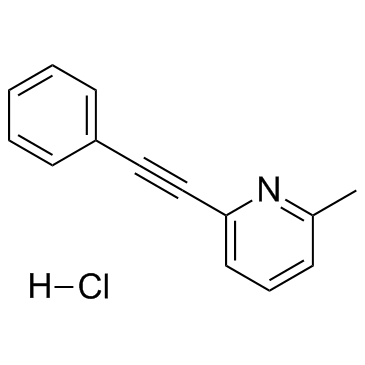MPEP (Hydrochloride)

MPEP (Hydrochloride) structure
|
Common Name | MPEP (Hydrochloride) | ||
|---|---|---|---|---|
| CAS Number | 219911-35-0 | Molecular Weight | 229.705 | |
| Density | 1.1g/cm3 | Boiling Point | 336.3ºC at 760mmHg | |
| Molecular Formula | C14H12ClN | Melting Point | N/A | |
| MSDS | Chinese USA | Flash Point | 144.8ºC | |
|
Group I metabotropic glutamate receptor-mediated activation of PKC gamma in the nucleus accumbens core promotes the reinstatement of cocaine seeking.
Addict. Biol. 20(2) , 285-96, (2015) Emerging evidence indicates that type I metabotropic glutamate receptors (mGluRs) in the nucleus accumbens play a critical role in cocaine seeking. The present study sought to determine the role of accumbens core mGluR1, mGluR5 and protein kinase C (PKC) in c... |
|
|
Endocannabinoids mediate bidirectional striatal spike-timing-dependent plasticity.
J. Physiol. 593 , 2833-49, (2015) Although learning can arise from few or even a single trial, synaptic plasticity is commonly assessed under prolonged activation. Here, we explored the existence of rapid responsiveness of synaptic plasticity at corticostriatal synapses in a major synaptic le... |
|
|
Estradiol mediates dendritic spine plasticity in the nucleus accumbens core through activation of mGluR5.
Brain Struct. Funct. 220 , 2415-22, (2015) Accumulating evidence from human and rodent studies suggests that females are more sensitive to the motivating and rewarding properties of drugs of abuse. Numerous reports implicate estradiol in enhancing drug-related responses in females, yet the neurobiolog... |
|
|
Group I metabotropic glutamate receptors: a potential target for regulation of proliferation and differentiation of an immortalized human neural stem cell line.
Basic Clin Pharmacol Toxicol. 116(4) , 329-36, (2015) Human neural stem cells (NSCs) from the developing embryo or the subventricular zone of the adult brain can potentially elicit brain repair after injury or disease, either via endogenous cell proliferation or by cell transplantation. Profound knowledge of the... |
|
|
Insights into the interaction of negative allosteric modulators with the metabotropic glutamate receptor 5: discovery and computational modeling of a new series of ligands with nanomolar affinity.
Bioorg. Med. Chem. 23 , 3040-58, (2015) Metabotropic glutamate receptor 5 (mGlu5) is a biological target implicated in major neurological and psychiatric disorders. In the present study, we have investigated structural determinants of the interaction of negative allosteric modulators (NAMs) with th... |
|
|
Contrasting actions of group I metabotropic glutamate receptors in distinct mouse striatal neurones.
J. Physiol. 592(Pt 13) , 2721-33, (2014) In mouse striatum, metabotropic glutamate receptor (mGluR) activation leads to several modulatory effects in synaptic transmission. These effects range from dampening of glutamate release from excitatory terminals to depolarization of divergent classes of int... |
|
|
Prolonged administration of antidepressant drugs leads to increased binding of [(3)H]MPEP to mGlu5 receptors.
Neuropharmacology 84 , 46-51, (2014) Metabotropic glutamate 5 (mGlu5) receptors are functionally connected with NMDA receptors. The antidepressant activity of the NMDA receptor antagonist ketamine in both preclinical and clinical studies, along with the antidepressant-like activities of negative... |
|
|
Pannexin-1-mediated ATP release from area CA3 drives mGlu5-dependent neuronal oscillations.
Neuropharmacology 93 , 219-28, (2015) The activation of Group I metabotropic glutamate receptors (GI mGluRs) in the hippocampus results in the appearance of persistent bursts of synchronised neuronal activity. In response to other stimuli, such activity is known to cause the release of the purine... |
|
|
Dual depolarization responses generated within the same lateral septal neurons by TRPC4-containing channels.
Pflugers Arch. 466(7) , 1301-16, (2014) In the central nervous system, canonical transient receptor potential (TRPC) channels have been implicated in mediating neuronal excitation induced by stimulating metabotropic receptors, including group 1 metabotropic glutamate receptors (mGluRs). Lateral sep... |
|
|
Astrocyte inositol triphosphate receptor type 2 and cytosolic phospholipase A2 alpha regulate arteriole responses in mouse neocortical brain slices.
PLoS ONE 7(8) , e42194, (2012) Functional hyperemia of the cerebral vascular system matches regional blood flow to the metabolic demands of the brain. One current model of neurovascular control holds that glutamate released by neurons activates group I metabotropic glutamate receptors (mGl... |